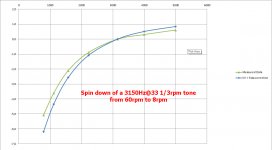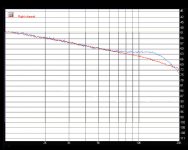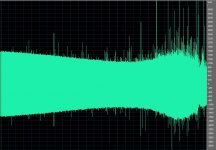Understand that I am not saying the CH Precision record is or isn't accurate. So let's instead say it's the Diyaudio test record, and we identify such an anomaly based on playback with your cart. We choose that your cart must be right so we re-eq the test record. Ta da. But we are no closer to the absolute answer, despite your cart now reading dead flat. Scott still gets alternate results and we are none the wiser.How could the CH Precision record give a perfect 10db/dec line from 2kHz up to 30kHz when having 2-3dB errors at 5kHz ?
I don't get your point.
Thanks Bill, am thinking about how to use a common reference to break the circle...……
LD
and why should your Cart have a 2-3dB error at 5kHz ?
Because it does, I already said I spun a fixed tone (3150kHz) over a wide range of RPM and it had the same -2.5dB of error at 5k. This test is unambiguous there is no involvement of the cutter response or equalization. Unless of course Lucky can say there is some vinyl/stylus interface issue which seems unlikely at this level.
At some point you will have to converge your arguments even when there are still some doubts.Trust you can see this is circular, and a matter of selection of specific test records to obtain a set result: even then subject to restrictions.
LD
You will never get a 100% situation.
And that brings me back to the initial goals of this thread: Why do MM carts have a dent in their FR response and has this to do with resonance of the cantilever.
To be able to measure such dents and find a prove for resonances, you need a reference.
So I'm still interested in your definition in plain English of a Cart beyond suspicion with these goals in mind.
Hans
I agree: can't see a defect here.Because it does, I already said I spun a fixed tone (3150kHz) over a wide range of RPM and it had the same -2.5dB of error at 5k. This test is unambiguous there is no involvement of the cutter response or equalization. Unless of course Lucky can say there is some vinyl/stylus interface issue which seems unlikely at this level.
LD
O.K., I understand, I missed that point.Because it does, I already said I spun a fixed tone (3150kHz) over a wide range of RPM and it had the same -2.5dB of error at 5k. This test is unambiguous there is no involvement of the cutter response or equalization. Unless of course Lucky can say there is some vinyl/stylus interface issue which seems unlikely at this level.
As you know I also did this test and corrected for speed and riaa errors
Cartridge dynamic behaviour
and although I did not go as far as 5kHz, the errors from 3.5khz to 300Hz were below 0.5dB.
If you could sent me your .Wav file, I could see what results I can extract.
But let me ask it in a different way.
When a FR from PN is a straight line at 10db/dec, how could there possibly be a 2-3dB error at some point on that line, unless the whole line is lifted by 2-3dB ?
Hans
I agree: can't see a defect here.
LD
I'm set up and willing to take some more data from different LP's.
As I see it Adjust + and the CH LP are aimed at folks with $$$ TT setups. Who is it to say they didn't take their preferred cart and linear tracking arm and simply get their test LP's to conform perfectly to what they thought was "right". Clearly the folks having the LP's made have no way to independently verify the results except by playing them.
I'm set up and willing to take some more data from different LP's.
As I see it Adjust + and the CH LP are aimed at folks with $$$ TT setups. Who is it to say they didn't take their preferred cart and linear tracking arm and simply get their test LP's to conform perfectly to what they thought was "right". Clearly the folks having the LP's made have no way to independently verify the results except by playing them.
Do you really mean that ?
I’m rather dissapointed in that not very scientific Calimero approach.
Because they are big and I’m small.
Hans
I think it was lost in translation Hans. Scott was merely pointing out that there is no accredited/accepted way to measure what is on a record other than play it. You can do some optical analysis on mono grooves with sinusoids, but for stereo all bets are off.
Does Jan still know a man with an ELP? Might be interesting to see what that makes of the record.
I think we are making progress here, just too early to conclude anything.
Does Jan still know a man with an ELP? Might be interesting to see what that makes of the record.
I think we are making progress here, just too early to conclude anything.
I think it was lost in translation Hans.
Yes, I see folks who have "done this for 20 yr. and tried everything" and what I've come up with is "perfect" to my ears. So of course any test must show it is perfect. A very common audiophile vanity. Someone in Boston must have a laser player but there is still the TT and EQ from constant amplitude that probably can not be defeated without serious in the box activity.
Lucky if you have a test LP of early European origin that you trust that I could search for I could have Jan bring it to the US and mail it here. I tried to give away some stuff to Bill but the shipping was $500 (not that he needs another project).
Decca SXL 2057 (1958) and Decca LXT 5346 (1958?) are the two I chose, just on the basis the Decca boys were supreme engineers at that time. Certainly SXL and LXT records generally are superb sounding recordings and pressings, and some pretty fine performances thrown in between, but I accept that doesn't confer absolute accuracy. Which is tough to establish. I think these were validated optically, IIRC I read somewhere: they are spots and sweeps so lend themselves.Lucky if you have a test LP of early European origin that you trust that I could search for I could have Jan bring it to the US and mail it here. I tried to give away some stuff to Bill but the shipping was $500 (not that he needs another project).
To extend the f range one has to play at higher speeds.
They are still about on auction sites etc, and not that expensive when I last looked.
LD
Thank you Bill.I think it was lost in translation Hans. Scott was merely pointing out that there is no accredited/accepted way to measure what is on a record other than play it. You can do some optical analysis on mono grooves with sinusoids, but for stereo all bets are off.
I think we are making progress here, just too early to conclude anything.
You gave us a link somewhere in the past pointing to a Philips article where shellac an vinyl where pressed with the same info, but both resulting in different and in non perfect FR's because of the interaction between record material and the Cart's tip mass.
It made it clear that a perfect record is hardly possible.
To get a perfect FR, one can take a perfect record and play it by a perfect cart, but that seems hard if not impossible, or one tunes a record to a good cart and match them to a perfect result.
That's the road that CH Precision and many others took and also LD suggested a second pressing for the DIY Audio record to get things straight.
But this can only be done when one has a cart without suspicion, so there we are back where we began, because according to LD cart's without suspicion do not exist.
It doesn't matter to me which record we take, since for whatever reason the CH Precision disk is not to be preferred, although I can't imagine they had my cart in mind, but as long as we don't decide on a standard, it will not be possible to make any progress.
I'm still left with the question, how do we know this standard record will be perfect when we have no cart without suspicion to check it ??
An optical check doesn't tell a thing of the interaction between record material and tip mass.
Maybe you and LD could compare the CH record to one reference record in his collection. When the outcome is the same to an acceptable margin, then we have made a real progress.
Just an idea ?
Hans
Actually it's not a suggestion, just an illustration that the audio world expects and understands straight flat lines, and tuning the source eq is what I venture we would naturally do to obtain. Few people would understand anything else; whereas actually it is deviation from absolute that designers/investigators like us are most interested in. Trouble is, without knowing what source tuning was applied, we cannot know what a flat line represents. So this actually obstructs our aims, even if it looks and feels reassuring it is 'wrong' IMO.That's the road that CH Precision and many others took and also LD suggested a second pressing for the DIY Audio record to get things straight.
LD
. I tried to give away some stuff to Bill but the shipping was $500 (not that he needs another project).
My wife has failed completely to get me to understand the difference between 'want' and 'need'. And since I cleared one project that has been waiting 21 years I have an enormous air of optimism.
Oh and I can afford the shipping now which I couldn't at the time.
Whilst I feel bad for having not really been able to contribute much here and not even kept on top of all of what is happening I do think we are closing in on something. I'm not sure we'll find anything completely new, but it will be something that was forgotten 40+ years ago.
Over the weekend I realised that I've had something wrong in my understanding in that I've only been considering the coil as an element in a circuit without thinking about the generator aspect of it. I suspect that is why I've been getting confused by some of LDs comments.
All good fun though!
Over the weekend I realised that I've had something wrong in my understanding in that I've only been considering the coil as an element in a circuit without thinking about the generator aspect of it. I suspect that is why I've been getting confused by some of LDs comments.
All good fun though!
Well, it exercises the mind for sure.All good fun though!
I suppose a cartridge coil is most like the secondary of an iron cored transformer whose primary is virtual and in the form of flux changes arising from armature motion. Whilst one can model such a primary in electronic terms, really it is electromechanical so non-ideals such as armature losses belong to that domain.
Behaviour as a transformer, in terms of permeable core behaviour ought to be observable from the 2 wires of the secondary, which is where we have been looking. I am still confused as to whether George's tests show f dependent inductance change and real loss, and how to reconcile that with Davidsrsb's results?
So I think it's a game of 2 halves: the coil as a transformer winding (inductor), and the armature as a source of flux changes. And I think behaviour and losses at small signal levels of vinyl playback is what matters.
Personally, I'm equally poor at electronics as I am at magnetic and mechanics, so I have no leaning to reduce everything to electrical analogy. And some of the transmission and loss mechanisms prob aren't minimum phase in the transformer primary analogy anyway.
LD
Scott made a spin down from an 3150Hz@33 1/3rpm tone starting at a much higher speed and measured from 5Khz and downwards.
He reported a velocity error of 2-3dB at 5kHz.
On the other hand, our PN spectra from the same record matched perfectly from 1kHz to 6kHz.
For that reason I made the same spin down, this time from 60.75rpm downwards, now also starting my measurements at 5kHz.
The image below shows the measured data versus the calculated curve, being corrected for velocity and Riaa.
There is no such deviation of 2-3dB visible at 5kHz, and since it is difficult to measure this with a reasonable precision, there must have some error slipped into Scott's measurement/calculation.
Because having the same PN curve from 1-6kHz, but having a difference in velocity errors of 2-3dB at 5kHz, simply do not match.
Hans
P.S. The 30.1Mb .wav file used for making the spin down image is way too large to post it here, so send me a PM if you want it.
He reported a velocity error of 2-3dB at 5kHz.
On the other hand, our PN spectra from the same record matched perfectly from 1kHz to 6kHz.
For that reason I made the same spin down, this time from 60.75rpm downwards, now also starting my measurements at 5kHz.
The image below shows the measured data versus the calculated curve, being corrected for velocity and Riaa.
There is no such deviation of 2-3dB visible at 5kHz, and since it is difficult to measure this with a reasonable precision, there must have some error slipped into Scott's measurement/calculation.
Because having the same PN curve from 1-6kHz, but having a difference in velocity errors of 2-3dB at 5kHz, simply do not match.
Hans
P.S. The 30.1Mb .wav file used for making the spin down image is way too large to post it here, so send me a PM if you want it.
Attachments
Decca SXL 2057 (1958) and Decca LXT 5346 (1958?) are the two I chose, just on the basis the Decca boys were supreme engineers at that time. Certainly SXL and LXT records generally are superb sounding recordings and pressings, and some pretty fine performances thrown in between, but I accept that doesn't confer absolute accuracy. Which is tough to establish. I think these were validated optically, IIRC I read somewhere: they are spots and sweeps so lend themselves.
To extend the f range one has to play at higher speeds.
LD
Thank you for mentioning records that could be used as references.
However, the SXL goes to 12kHz and not beyond, so seemingly not fit for our purposes and the LXT 5346 is recorded at 0dB@1kHz and +12,5dB@18kHz, seems a bit stressful compared to other testdiscs at -20dB@1kHz..
Speeding this record up for higher frequencies will make the level go up even further.
What about the Denon XG-7002 record that JP used.
Do you have any way to find out the quality of this record ?
Hans
There is no such deviation of 2-3dB visible at 5kHz, and since it is difficult to measure this with a reasonable precision, there must have some error slipped into Scott's measurement/calculation.
No it's not the Hilbert transform yields the instantaneous frequency and amplitude directly, (here 30sec as a 1,323,000 point transform) there are no errors in my measurement. This is the same technique I used to reproduce Lucky's turntable speed circular plot. After some work we got the two to almost lineup perfectly.
I think that if I interpose an RCA to XLR connector on my sound card I can fool it into using the mic pre-amp so now I can easily repeat measurements.
Last edited:
Han's this is the 1k to 20k section of the Adjust + sweep on side B my cart has the mid-range dip the PN can not be flat. The pre-amp is ~ +-0.1dB to RIAA. I used my pre-amp here this is an almost perfect match to the flat CV sweep on the CBS disk.
Attachments
Last edited:
- Status
- Not open for further replies.
- Home
- Source & Line
- Analogue Source
- Cartridge dynamic behaviour


